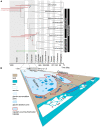Cryogenian Glacial Habitats as a Plant Terrestrialisation Cradle - The Origin of the Anydrophytes and Zygnematophyceae Split
- PMID: 35154170
- PMCID: PMC8829067
- DOI: 10.3389/fpls.2021.735020
Cryogenian Glacial Habitats as a Plant Terrestrialisation Cradle - The Origin of the Anydrophytes and Zygnematophyceae Split
Abstract
For tens of millions of years (Ma), the terrestrial habitats of Snowball Earth during the Cryogenian period (between 720 and 635 Ma before present-Neoproterozoic Era) were possibly dominated by global snow and ice cover up to the equatorial sublimative desert. The most recent time-calibrated phylogenies calibrated not only on plants but on a comprehensive set of eukaryotes indicate that within the Streptophyta, multicellular charophytes (Phragmoplastophyta) evolved in the Mesoproterozoic to the early Neoproterozoic. At the same time, Cryogenian is the time of the likely origin of the common ancestor of Zygnematophyceae and Embryophyta and later, also of the Zygnematophyceae-Embryophyta split. This common ancestor is proposed to be called Anydrophyta; here, we use anydrophytes. Based on the combination of published phylogenomic studies and estimated diversification time comparisons, we deem it highly likely that anydrophytes evolved in response to Cryogenian cooling. Also, later in the Cryogenian, secondary simplification of multicellular anydrophytes and loss of flagella resulted in Zygnematophyceae diversification as an adaptation to the extended cold glacial environment. We propose that the Marinoan geochemically documented expansion of first terrestrial flora has been represented not only by Chlorophyta but also by Streptophyta, including the anydrophytes, and later by Zygnematophyceae, thriving on glacial surfaces until today. It is possible that multicellular early Embryophyta survived in less abundant (possibly relatively warmer) refugia, relying more on mineral substrates, allowing the retention of flagella-based sexuality. The loss of flagella and sexual reproduction by conjugation evolved in Zygnematophyceae and zygomycetous fungi during the Cryogenian in a remarkably convergent way. Thus, we support the concept that the important basal cellular adaptations to terrestrial environments were exapted in streptophyte algae for terrestrialization and propose that this was stimulated by the adaptation to glacial habitats dominating the Cryogenian Snowball Earth. Including the glacial lifestyle when considering the rise of land plants increases the parsimony of connecting different ecological, phylogenetic, and physiological puzzles of the journey from aquatic algae to terrestrial floras.
Keywords: Anydrophyta; Charophyta; Cryogenian glaciation; Embryophyta; Snowball Earth; Streptophyta; Zygnematophyceae; plant evolution.
Copyright © 2022 Žárský, Žárský, Hanáček and Žárský.
Conflict of interest statement
The authors declare that the research was conducted in the absence of any commercial or financial relationships that could be construed as a potential conflict of interest.
Figures



Similar articles
-
Cryogenian Origins of Multicellularity in Archaeplastida.Genome Biol Evol. 2024 Feb 1;16(2):evae026. doi: 10.1093/gbe/evae026. Genome Biol Evol. 2024. PMID: 38333966 Free PMC article.
-
Snow ball earth and the split of Streptophyta and Chlorophyta.Trends Plant Sci. 2013 Apr;18(4):180-3. doi: 10.1016/j.tplants.2012.09.010. Epub 2012 Oct 23. Trends Plant Sci. 2013. PMID: 23102566
-
Genomes of Subaerial Zygnematophyceae Provide Insights into Land Plant Evolution.Cell. 2019 Nov 14;179(5):1057-1067.e14. doi: 10.1016/j.cell.2019.10.019. Cell. 2019. PMID: 31730849
-
Zygnematophyceae: from living algae collections to the establishment of future models.J Exp Bot. 2020 Jun 11;71(11):3296-3304. doi: 10.1093/jxb/eraa091. J Exp Bot. 2020. PMID: 32076703 Review.
-
Plant evolution: landmarks on the path to terrestrial life.New Phytol. 2018 Mar;217(4):1428-1434. doi: 10.1111/nph.14975. Epub 2018 Jan 10. New Phytol. 2018. PMID: 29318635 Review.
Cited by
-
Silurian Climatic Zonation of Cryptospore, Trilete Spore and Plant Megafossils, with Emphasis on the Přídolí Epoch.Life (Basel). 2024 Feb 16;14(2):258. doi: 10.3390/life14020258. Life (Basel). 2024. PMID: 38398767 Free PMC article.
-
The cell biology of charophytes: Exploring the past and models for the future.Plant Physiol. 2022 Oct 27;190(3):1588-1608. doi: 10.1093/plphys/kiac390. Plant Physiol. 2022. PMID: 35993883 Free PMC article.
-
Ecosystem relocation on Snowball Earth: Polar-alpine ancestry of the extant surface biosphere?Proc Natl Acad Sci U S A. 2025 May 20;122(20):e2414059122. doi: 10.1073/pnas.2414059122. Epub 2025 May 5. Proc Natl Acad Sci U S A. 2025. PMID: 40324073
-
Amoebozoan testate amoebae illuminate the diversity of heterotrophs and the complexity of ecosystems throughout geological time.Proc Natl Acad Sci U S A. 2024 Jul 23;121(30):e2319628121. doi: 10.1073/pnas.2319628121. Epub 2024 Jul 16. Proc Natl Acad Sci U S A. 2024. PMID: 39012821 Free PMC article.
-
A nuclear Pandora's box: functions of nuclear envelope proteins in cell division.AoB Plants. 2022 Dec 25;15(2):plac065. doi: 10.1093/aobpla/plac065. eCollection 2023 Feb. AoB Plants. 2022. PMID: 36779223 Free PMC article. Review.
References
-
- Agić H., Moczydłowska M., Yin L. (2017). Diversity of organic-walled microfossils from the early Mesoproterozoic Ruyang Group, North China Craton - A window into the early eukaryote evolution. Precambrian Res. 297 101–130. 10.1016/j.precamres.2017.04.042 - DOI
-
- Bai H., Kuang H., Liu Y., Peng N., Chen X., Yuchong Wang Y. (2020). Marinoan-aged red beds at Shennongjia, South China: evidence against global-scale glaciation during the Cryogenian. Palaeogeogr. Palaeoclimatol. Palaeoecol. 559:109967. 10.1016/j.palaeo.2020.109967 - DOI
-
- Barkat R., Chakraborty P. P., Saha S., Das K. (2020). Alluvial architecture, paleohydrology and provenance tracking from the Neoproterozoic Banganapalle formation, Kurnool Group, India: an example of continental sedimentation before land plants. Precambrian Res. 350:105930. 10.1016/j.precamres.2020.105930 - DOI
LinkOut - more resources
Full Text Sources

